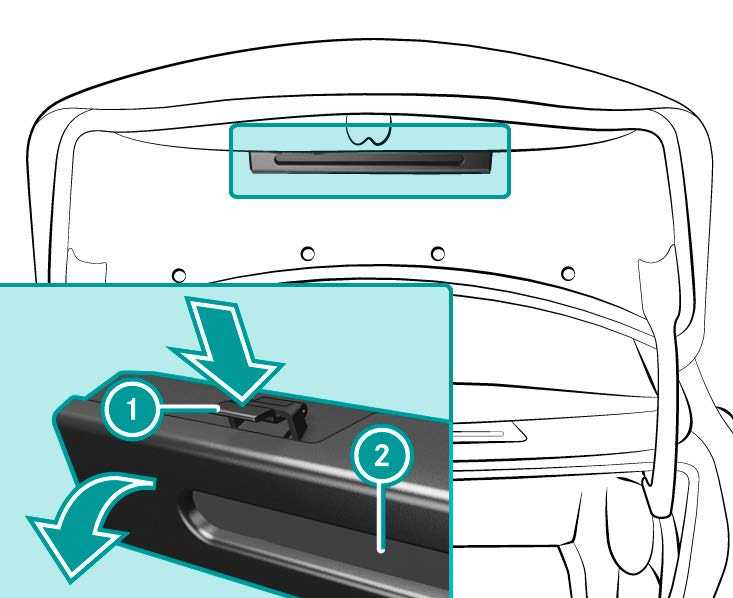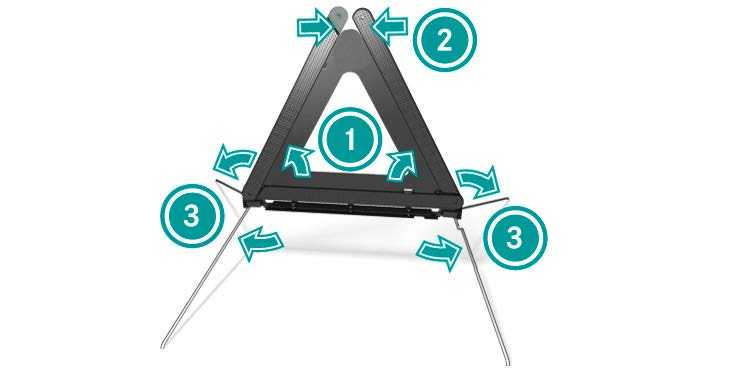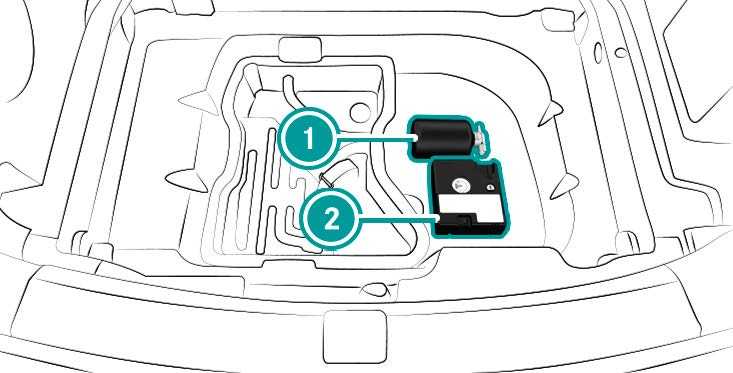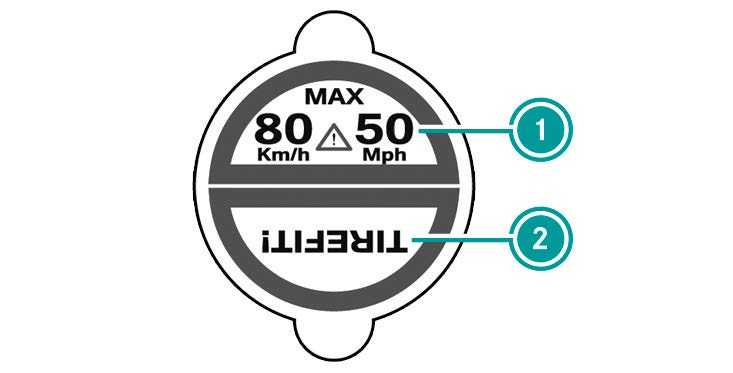Mercedes-Benz E-CLASS SEDAN 2023 Emergency User Manual
Emergency
Removing the Safety Vest
The safety vests are located in the stowage compartments in the driver’s and front passenger door.
- Pull out the safety vest bag by the loop.
- Open the safety vest bag and pull out the safety vest.
- There are also safety vest compartments in the rear door stowage compartments in which safety vests can be stored.

- Maximum number of washes
- Maximum wash temperature
- Do not bleach
- Do not iron
- Do not tumble dry
- Do not dry clean
- Class 2 safety vest
The requirements defined by the legal standard are fulfilled only if the safety vest is the correct size and is fully closed.
Replace the safety vest in the following cases:
- The reflective strips are damaged or dirty
- The maximum permissible number of washes is exceeded
- The fluorescence has faded, e.g. due to continued exposure to sunlight.
Dispose of the reflective safety jacket in an environmentally responsible manner:
- To do so, contact your local waste disposal company.
Warning triangle
Removing the warning triangle
- Push both sides of warning triangle holder 1 in the direction of the arrow and open it.
- Remove warning triangle 2.
Setting up the warning triangle

- Fold side reflectors 1 upwards to form a triangle and attach at the top using upper press-stud 2.
- Fold legs 3 down and out to the side.
First-aid kit (soft-sided) overview
First-aid kit (soft-sided) 1 is located on the left or right side of the trunk, depending on the vehicle version.
On vehicles with Burmester® Surround Sound System, a first-aid kit (soft-sided) is located in the trunk when the vehicle is delivered.
Flat tire
Notes on flat tires
WARNING
Risk of accident due to a flat tire
A flat tire severely affects the driving characteristics as well as the steering and braking of the vehicle.
Tires without run-flat characteristics:
- Do not drive with a flat tire.
- Change the flat tire immediately with an emergency spare wheel or spare wheel. Alternatively, consult a qualified specialist workshop.
Tires with run-flat characteristics:
- Observe the information and warning notes on MO Extended tires (run-flat tires).
In the event of a flat tire, the following options are available depending on your vehicle’s equipment:
- Vehicles with MO Extended tires: it is possible to continue the journey for a short period of time. Make sure you observe the notes on MO Extended tires (run-flat tires)
page 296). - Vehicles with a TIRE FIT kit: you can seal the tire so that it is possible to continue the journey for a short period of time. To do this, use the TIRE FIT kit (/ page 297).
- Vehicles with Mercedes I connect: you can make a call for breakdown assistance via the overhead control panel in the case of a breakdown (/ page 259).
- All vehicles: change the wheel (/ page 337).% The emergency spare wheel is only available in certain countries.
Notes on MO Extended tires (run-flat tires)
WARNING
Risk of an accident when driving in limp-home mode
When driving in emergency mode the handling characteristics are impaired.
- Do not exceed the specified maximum speed of the MOExtended tires.
- Avoid any abrupt steering and driving maneuvers as well as driving over obstacles (curbs, potholes, off-road). This applies, in particular, to a loaded vehicle.
- Stop driving in emergency mode if you notice:
- Banging noise
- Vehicle vibration
- Smoke that smells like rubber
- Continuous ESP® intervention
- Cracks in the tire side walls
- After driving in emergency mode, have the rims checked by a qualified specialist workshop with regard to their further use..
- The defective tire must be replaced in every case.
With MO Extended tires (run-flat tires), you can continue to drive your vehicle even if there is a total loss of pressure in one or more tires. However, the affected tire must not show signs of clearly visible damage. You can recognize MO Extended tires by the MOExtended marking which appears on the side wall of the tire. Vehicles with a tire pressure loss warning system: MOExtended tires may only be used in conjunction with an activated tire pressure loss warning system. Vehicles with a tire pressure monitoring system: MOExtended tires may only be used in conjunction with an activated tire pressure monitoring system.
If a pressure loss warning message appears in the driver’s display, proceed as follows:
- Check the tire for damage.
- Driving distance possible in emergency mode after the pressure loss warning:
- If driving on, observe the following notes.
| Load condition | Driving distance possible in emergency mode |
| Partially laden | 50 miles (80 km) |
| Fully laden | 19 miles (30 km) |
The driving distance possible in emergency mode may vary depending on the driving style. Observe the maximum permissible speed of 50 mph (80 km/h).
If a tire has gone flat and cannot be replaced with an extended tire, you can use a standard tire as a temporary measure.
TIRE FIT kit storage location
The TIRE FIT kit is located under the trunk floor.
- Tire sealant bottle
- Tire inflation compressor
Depending on the vehicle version, the TIRE FIT kit may also be located in other places under the boot floor.
- You can find information on the power category (LK) and/or electrical data on the back of the tire inflation compressor:
R LK2 – 12 V/15 A, 180 W, 1.8 lbs (0.8 kg) At a distance of approximately 3.3 ft (1 m) to the tire inflation compressor and approximately 5.2 ft (1.6 m) above the ground, the following sound pressure levels apply:
R Emissions sound pressure level LPA 83 dB (A)
R Sound power level LWA 91 dB (A)
The tire inflation compressor is maintenance-free. If there is a malfunction, please contact a qualified specialist workshop.
Using the TIRE FIT kit
Requirements
- The tire sealant bottle and tire inflator compressor are ready for use (/ page 297).
- TIRE FIT sticker is present.
- Gloves are present.
You can use TIRE FIT tire sealant to seal perforation damage of up to 0.16 in (4 mm), particularly those in the tire tread. You can use TIRE FIT in out-side temperatures down to -4 °F (-20 °C).
WARNING
Risk of an accident when using tire sealant
The tire sealant may be unable to seal the tire properly, especially in the following cases:
- There are large cuts or punctures in the tire (larger than the damage previously mentioned)
- The wheel rims have been damaged
- After journeys with very low tire pressure or with flat tires
- Do not continue driving.
- Consult a qualified specialist workshop.
WARNING
Risk of injury and poisoning from tire sealant
The tire sealant is harmful and causes irritation. Do not allow it to come into contact with the skin, eyes or clothing, and do not swallow it. Do not inhale tire sealant fumes. Keep the tire sealant away from children.
If you come into contact with the tire sealant, observe the following:
- Rinse off the tire sealant from your skin immediately using water.
- If tire sealant gets into your eyes, thoroughly rinse out the eyes using clean water.
- If tire sealant has been swallowed, immediately rinse out the mouth thoroughly and drink plenty of water. Do not induce vomiting and seek medical attention immediately.
- Change out of any clothes contaminated with tire sealant immediately.
- If allergic reactions occur, seek medical attention immediately.
NOTE
Overheating due to the tire inflation compressor running too long
- Do not run the tire inflation compressor for longer than ten minutes without interruption.
Comply with the manufacturer’s safety notes on the sticker on the tire inflation compressor.
Have the tire sealant bottle replaced in a qualified specialist workshop every five years?
- Do not remove any foreign objects that have entered the tire.

- Affix part 1 of the TIRE FIT sticker to the instrument cluster within the driver’s field of vision.
- Affix part 2 of the TIRE FIT sticker near the valve on the wheel with the defective tire.

- Pull plug 4 with the cable and hose 5 out of the tire inflation compressor housing.
- Push the plug of hose 5 into flange 6 of tire sealant bottle 1 until the plug engages.
- Place tire sealant bottle 1 head downwards into recess 2 of the tire inflation compressor.

- Remove the valve cap from valve 7 on the faulty tire.
- Screw filling hose 8 onto valve 7.
- Insert plug 4 into a 12‑V‑socket in your vehicle.
- Switch on the vehicle.
- Switch on the tire inflation compressor using the On/Off switch 3.
The tire is inflated. First, tire sealant is pumped into the tire. The pressure may briefly rise to approximately 500 kPa (5.0 bar/73 psi).
Do not switch off the tire inflation compressor during this phase!
- Let the tire inflation compressor run for a maximum of ten minutes.
The tire should then have attained a tire pressure of at least 200 kPa (2.0 bar/29 psi).
If tire sealant leaks out, make sure you clean the affected area as quickly as possible. It is preferable to use clean water.
If you get tire sealant on your clothing, have it cleaned as soon as possible with perchloroethylene.
If, after ten minutes, a tire pressure of 200 kPa (2.0 bar/29 psi) has not been attained:
- Switch off the tire inflation compressor.
- Unscrew the filling hose from the valve of the defective tire.
Please note that tire sealant may leak out when unscrewing the filling hose. - Drive forward or in reverse very slowly for approximately 33 ft (10 m).
- Pump up the tire again.
After a maximum of ten minutes, the tire pressure must be at least 200 kPa (2.0 bar/29 psi).
WARNING
Risk of accident due to the specified tire pressure not being achieved
If the specified tire pressure is not achieved after the specified time, the tire is too badly damaged. The tire sealant cannot repair the tire in this instance.
The braking characteristics as well as the driving characteristics may be greatly impaired.
- Do not continue driving.
- Consult a qualified specialist workshop.
If, after ten minutes, a tire pressure of 200 kPa (2.0 bar/29 psi) has been attained:
- Switch off the tire inflation compressor.
- Unscrew the filling hose from the valve of the defective tire.
+ ENVIRONMENTAL NOTE Environmental pollution caused by environmentally irresponsible disposal
Tire sealant contains pollutants.
- Has the tire sealant bottle been disposed of professionally, e.g. at an authorized Mercedes-Benz Center?
- Stow the tire sealant bottle and the tire inflation compressor.
- Pull away immediately.
- Stop driving after approximately ten minutes and check the tire pressure using the tire inflation compressor.
The tire pressure must now be at least 130 kPa (1.3 bar/19 psi).
WARNING
Risk of accident due to the specified tire pressure not being attained If the specified tire pressure is not reached, the tire is too badly damaged. The tire sealant cannot repair the tire in this instance.
The braking and driving characteristics may be greatly impaired:
- Do not continue driving.
- Consult a qualified specialist workshop.
In cases such as the one mentioned above, contact an authorized Mercedes-Benz Center. Or call 1-800-FOR-MERCedes (in the USA) or 1-800-387-0100 (in Canada).
Correct the tire pressure if it is still at least 130 kPa (1.3 bar/19 psi). See the Tire and Loading Information placard on the B‑pillar on the driver’s side or the tire pressure table in the fuel filler flap for values.
- To increase the tire pressure: switch on the tire inflation compressor.

To reduce the tire pressure: press pressure
release button 1 next to manometer 2.
- When the tire pressure is correct, unscrew the filling hose from the valve of the sealed tire.
- Screw the valve cap onto the valve of the sealed tire.
- Pull the tire sealant bottle out of the tire inflation compressor.
The filling hose stays on the tire sealant bottle:
- Drive to the nearest qualified specialist workshop and have the tire, tire sealant bottle, and filling hose replaced there.
Mercedes-Benz 2023 Top Accessories
[amalinkspro_table id=”32446″ new-window=”on” nofollow=”on” addtocart=”off” /]
Reference Links
View Full User Guide: Mercedes-Benz E-CLASS SEDAN 2023 User Manual
Download Manuals: https://www.mbusa.com/en/owners/manuals
The E-Class Sedan includes Mercedes-Benz Emergency Call Service, which automatically contacts emergency services in case of a serious collision.
Yes, it is equipped with a comprehensive airbag system including front, side, and overhead airbags.
Yes, the vehicle automatically notifies emergency services in the event of a significant collision.
Features like active brake assist, attention assist, and blind-spot assist aid in preventing accidents and enhancing driver awareness.
Mercedes-Benz offers roadside assistance services for the E-Class Sedan, providing help for breakdowns or mechanical issues.
Active brake assist helps to prevent collisions by automatically applying the brakes if it detects an imminent collision.
Yes, the vehicle includes an SOS button for manually initiating a call to emergency services.
In an engine breakdown, safely pull over, turn on hazard lights, and contact Mercedes-Benz roadside assistance.
Most Mercedes-Benz vehicles come with a first aid kit, but it’s best to confirm for the specific E-Class model.
Attention assist monitors the driver’s behavior for signs of drowsiness or inattention and alerts them to take a break if needed.
Features like adaptive cruise control and lane-keeping assist are particularly useful for highway driving emergencies.
In city driving, features like pedestrian detection and city-speed brake assist are particularly beneficial.
A fire extinguisher is not standard but can be added as an accessory or part of a safety package.
The Mercedes-Benz Emergency Call Service is designed to contact local emergency services based on the vehicle’s location.
In an emergency, doors can be unlocked manually or automatically upon airbag deployment.
Useful Link
View Full User Guide: Mercedes-Benz E-CLASS SEDAN 2023 User Manual
Download Manuals: https://www.mbusa.com/en/owners/manuals
2023 Mercedes Benz E-Class Specs, Price, Features, Mileage (Brochure)


